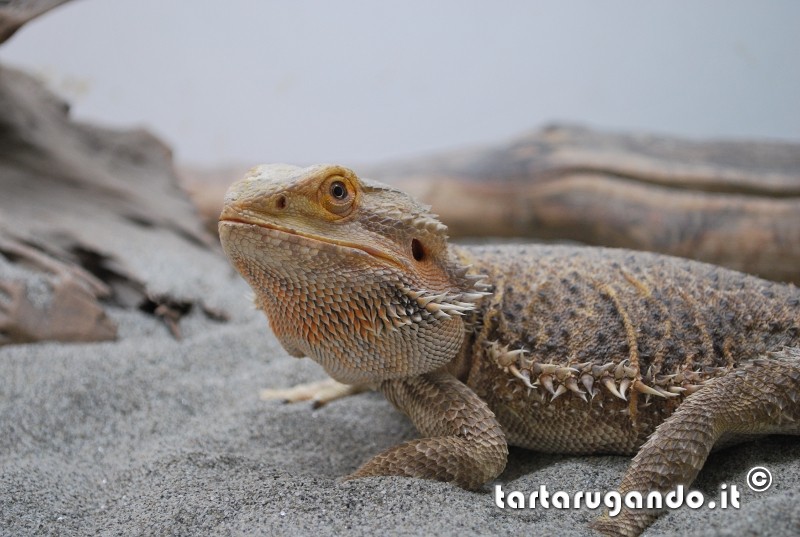
Classification
Class:Reptilia
Order: Squamata
Suborder: Sauria
Superfamily: Iguania
Family: Agamidae
Subfamily: Agaminae (50 Genus)
Genus: Pogona
The bearded dragon can reach lengths from 40 to 60 cm, limbs are short and robust, the tail is about one and a half times the body. The color varies from gray to brown; some specimens and color mutations have a strong red or yellow tint.
It’s distributed in the eastern part of central Australia, which, from the point of view of climate, is a dry area with little rain.
The predominant vegetation in the habitat of this lizard is typical of the dry forest, desert and savannah.
It’s the species more commercialized for the size, docile temperament and the possibility to select color variations.
Since 1980, Australia has started a restrictive policy regarding the exports.
The export ban has meant that these animals were not included in CITES lists, which has facilitated the movement (between European herpetophiles and U.S.ones) of animals originated from the reproduction of dragons that left Australia before 1980 or after illegally.
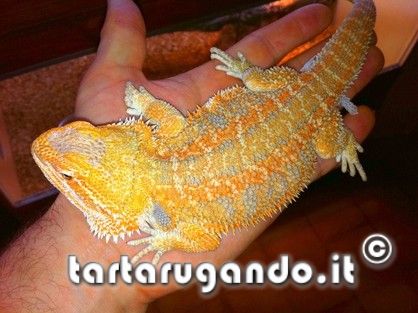
Terrarium
The terrarium for a Pogona can have variable dimensions in relation to the size of the animal.
To avoid having to replace the terrarium with a certain frequency, it is suggestable to use from the beginning a terrarium of 120x60x50h cm, dimensions that allow to keep a pair of these beautiful reptiles. The display cases commercially available can be constructed in different materials such as wood or glass, with suitable openings to ensure proper ventilation of the cage.
The ventilation is critical, in order to not make excessively increasing the humidity level that must be less than 40%.
Breeding rack sample
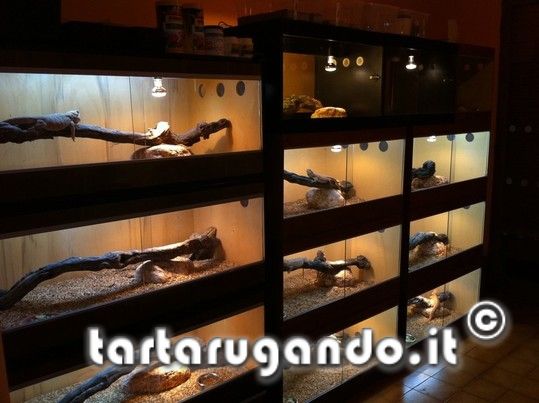
Biotope terrariums samples
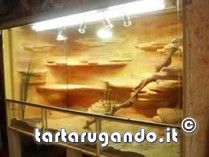
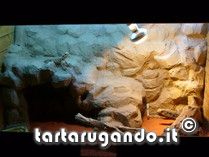
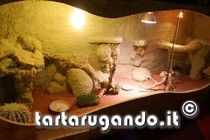

Biotope terrariums samples



UVB lights
Being Pogona a desert saurian, it requires an adequate lighting system. The terrarium must be provided with a compact lamp or neon light with a percentage of emission of UVB rays of at least 5/8%.
These lamps should be replaced every 6 months, regardless of what it’s written on the packaging. As UVB rays can have the desired effect on the animal, they have to reach it with no materials that can filter them such as glass, plastic, etc. .. more to this, lights need to be at a maximum distance of 30 cm from the animal so it can benefit.
A reptile in nature spends many hours a day to relax in the sun, absorbing many ultra violet rays (UVB). This wavelength is needed by the body to synthesize vitamin D3, essential to the proper absorption of calcium from the gastrointestinal tract.
Vitamin D3 is synthesized in the skin and insufficient exposure to UVB radiation may predispose your pet to MOM (metabolic bone disease), a common condition in reptiles kept in a controlled environment that can be fatal if not detected in time
Neon tube e compact light
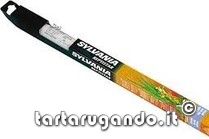
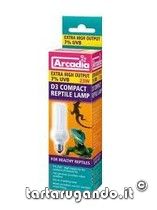
Heating
The terrarium, in addition to UVB lamps, must be prepared with a heating source. To do so, you can use a spot lamp that can be purchased in a hardware shop or DIY centers for a few Euros. It is very important that you purchase an adequate wattage, this is because the larger the terrarium, more watts should have the spot.
The terrarium should have a hot zone in which the temperature should be about 30/32° C, a cool area to be 26/28° C and a basking area (below the spot area) which must reach at least 45° C.
Absolutely avoid heating cables and heating mats (or rocks) that reproduce an unnatural heat source, Pogona in nature receives heat from above and not from below!
During the night, the temperature should never fall below 18 ° C and the photoperiod is 12 hours of light and 12 hours dark. If night temperatures should drop below 18 ° C, it’s better to use ceramic lamps regulated by a thermostat for heating during the night.
Spot lamps
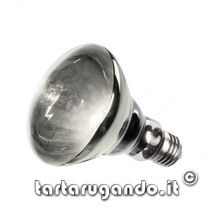
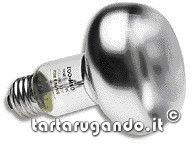
Terrarium furniture
For the welfare of the animals and to meet their needs as good climbers, enter the terrarium some branches or stones on which they can climb. Since they like to rest on a raised surface (trunk or stone) and enjoy the sun (UVB + spot) will be common to find them basking in the sun.
The substrate of the terrarium should be easy to clean and harmless to animals.
For this purpose you can use a mat of synthetic grass or rubber (indeed, more than one so that when you use one, you can wash the other) or paper (economic and easily replaceable).
The materials for the substrate such as sand, bark and other similar materials are highly choreographic and very beautiful to look at, but they have a major risk of contamination and the possibility that the Pogona may ingest it, resulting in constipation.
It is not recommended to use the sand until the animal has not reached the 25/30 cm in length.
Feeding
Pogona are from areas where food is sparsely distributed on the territory and for this, they accept a wide variety of different foods.
Bearded dragons are omnivorous eating both plant foods that animal, including insects.
They have good eyesight and a good sense of smell.
Young pogona in growth tend to be primarily carnivorous, while adults tend to be predominantly herbivorous (which, unfortunately, does not happen often, resulting in the occurrence of disease or death).
As a guideline, the diet should be 50% herbivorous and carnivorous 50%, with differences according to age.
In young subjects 70% 30% carnivores and herbivores, whereas in adults 70% 30% herbivores and carnivores.
They usually need to be fed 1-2 times a day up to 6 months of age, while adults can be fed with insects even 3 times a week, while vegetables should be served daily.
Young specimens under 2 months of age should be fed 2 times a day also.
Much will depend from the hunger of your bearded dragon, the important thing is not to overfeed it.
Vegetables
Pogona can be fed with both vegatables and flowers.
They can be used all green leafy vegetables such as endive, chicory, dandelion, arugula, radicchio (italian chicory) and red lettuce, peppers, zucchini.
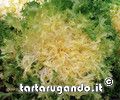

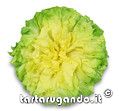

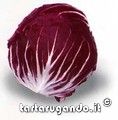
Insects
Crickets are the basis of their diet and now they can easily be bought even with shipment directly to your home.
In addition to crickets can be given cockroaches, buffalo worms (Zophobas morio) mealworms (Tenebrio molitor) and also insects such as moths lavrvae but only occasionally as it is very high in fat with the possibility that these determine liver disease such as steatosis and lipidosis.

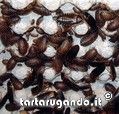
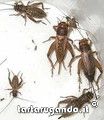



Integration
Very important will be to provide adequate integration calcium carbonate and calcium with vitamin D3 which can be found on the market at shops and specialized facilities.
So it will be sufficient to dust the vegetables and insects before serving. Calcium with vitamin D3 should be given twice a week, while the calcium carbonate the remaining days.
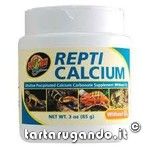
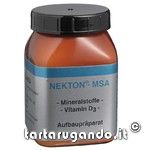
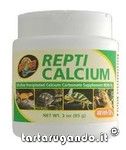
Reproduction
Pogona reaches sexual maturity at about 8/12 months. It is not recommended, however, to reproduce animals that have not reached a weight of at least 250/300 gm.
A pregnant female will immediately recognize the bloated abdomen, the significant increase of appetite and the incessant frenzy of digging.
For this, you will have to put in the terrarium a deposition box filled with sand or moist peat, I personally use river sand, you will notice that the animal will begin to dig incessantly in the box to look for a spot to lay their eggs. A healthy and well-fed animal can lay from 20 to 30 eggs. It can also lay more than once even if has been paired once, this may occur because a sperm retention.
Once laid the eggs must be removed and placed in a container with a lid, inside the container will be placed in the wet vermiculite in a ratio of 1:1 or 1:0.8 (water 100 grams - 100 grams or 100 grams vermiculite vermiculite - 80 grams water). Lay their eggs above the vermiculite with great delicacy and close the lid of the container, once closed will be useful to write down the weight in order to control any evaporated water and add it if necessary, then enter the container inside the incubator and set a temperature of 28/30 degrees, the eggs hatch at these temperatures occurs in about 50/60 days.
Pairing
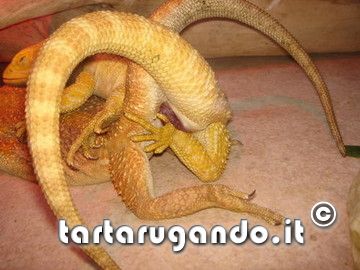
Egg laying
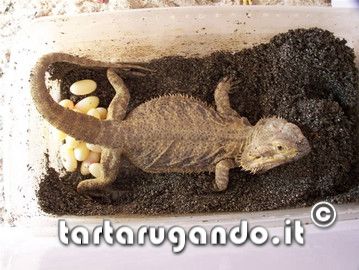
Box with vermiculite where to place the eggs
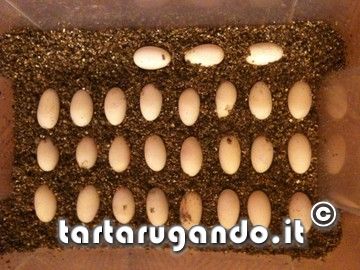
Egg hatching
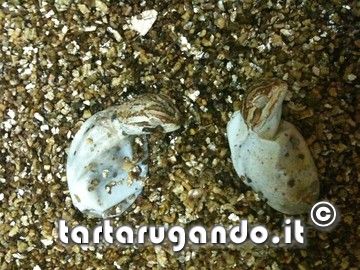
First day of life
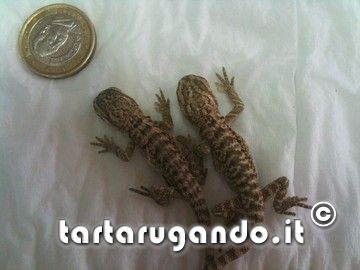
Babies management
Egg laying

Box with vermiculite where to place the eggs

Egg hatching

First day of life

One or two days before the egg hatching will begin to be present on the shell some water droplets. The babies generally hatch in time very close to each other, usually within 24 hours from the first hatching. Looking for the first time a hatching you can be tempted to help the babies to come out of the egg, because they seem exhausted and too weak to do so.
The hatching is not a quick and continuous process: the baby does energetic movements, then stops to rest motionless with eyes closed and often gives the impression of being dead or lifeless.
Most of the time everything is fine and it should not be tempted to help them out, in order to avoid to hurt them and damage to the umbilical vessels that can still be connected to the yolk sac.
Feeding will be the same as for adults, but adequately sized and naturally integrated with calcium. In principle, they are definitely more attracted by insects, but they can be easily get used to vegetables.
Immediately after hatching, babies must be kept on a substrate of soft paper slightly moistened, at a temperature of about 30 ° C, until they will be completely resorbed the yolk sac. This is to prevent infection or prolapse of the yolk sac through the umbilical scar.
After this period, babies should be kept in the same environmental conditions (photoperiod, light, temperature / thermal gradient, humidity) have already been described for adults.
Initially we will use small baskets of 80 X 60 X 40 for 4-5 pieces, with basic furnishings products, including at least one shelter and the paper substrate.
It is advisable to separate the babies in groups of few individuals to monitor more effectively every specimen, to avoid excessive competition for food and to separate the most vulnerable or overly aggressive.
Reptiles emergencies
It’s extremely wrong to consider reptiles as cold-blooded animals, as they are eterothermic and regulate their body temperature according to the temperature of the environment in which they live.
The ambient temperature therefore, affecting the body temperature, it also regulates the metabolism of the animal whose regular functioning is essential for the proper functioning of every organ and system of the body.
But what are the warning signs?
Here are some signs that can express a sign of illness:
• Incorrect management
• Loss of appetite
• Increased volume of the abdomen
• Difficulty breathing
• Runny nose
• Puffs and wheezing
• Changes in the color of the oral cavity
• yellowish or whitish plaques of the oral cavity
• Changes in the color of the plumage
• Absence of feces for long periods of time
• Presence of parasites in feces
• Abnormal body posture (lordosis, kyphosis, stargazing)
• Immobility and reluctance to move
• Weight loss
In case that your reptile present one of these clinical signs do not waste time, immediately contact a veterinarian who specializes in exotic animals.
In all exotic animals, especially reptiles, hesitate and let too much time from the onset of symptoms means compromising seriously the chances of recovery of your pet.
Reptiles’ surgery and medicine
A reptile can be a great pet and will become part of your family for many, many years. For the health of these wonderful pets, health management and disease prevention play a very important role.
The veterinarian that deals in a professional manner the health of your reptiles will be able to provide valuable advices on the prevention and treatment of diseases, and the management in a controlled environment of your pet.
Many diseases that affect the reptiles kept in home, in fact come by incorrect handling or an incorrect diet. Temperature, humidity and exposure to sunlight are among the first requirements to be met for the proper maintenance of the animal.
Why do I bring my reptile vet though apparently okay?
Of course, prevention is better than cure. It’s important to know that these animals, like birds, mask very well the clinical signs of disease. This is simply a survival instinct and every animal that shows signs of malaise in nature may be subject to attacks by predators or individuals of the same group. Show signs of discomfort only when their conditions are so severe to not allow it from masking. To prevent a sick reptile is a reptile dead, it is important that these species are brought in to visit as soon as it detects a slightest sign of discomfort, do not waste time or empirical evidence or hearsay.
Newly purchased animals or in a bad state of health must be to visit as soon as possible. The therapeutic attempts by hearsay or empirical, do not give any effect other than to seriously threaten the life of the animal and to undermine the work of the veterinary surgeon who will have to visit (as well as increase the cost of care necessary to heal ). Nowadays veterinarians, thanks to the enormous developments in science and diagnostic techniques can do a lot for your pets, but they can not do miracles when the situation is already seriously compromised!
Originally written by: Scorpedine
Translated by: Drakul
 Benvenuto su Tartarugando, il forum tematico specializzato nell'allevamento di tartarughe e di altri rettili.
Benvenuto su Tartarugando, il forum tematico specializzato nell'allevamento di tartarughe e di altri rettili.





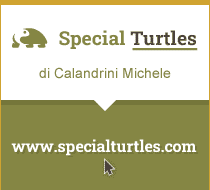
 Elenco delle sezioni
Elenco delle sezioni Elenco delle Categorie
Elenco delle Categorie Nuvola Tag
Nuvola Tag
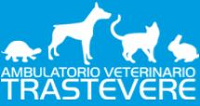
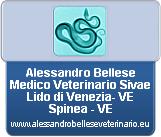

 Articoli recenti
Articoli recenti